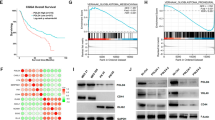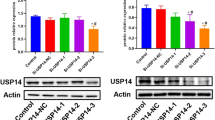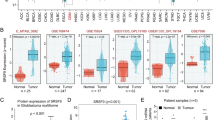Summary
The effects of RNAi-mediated gene silencing of LRIG3 expression on cell cycle and survival of human glioma cell line GL15 and the possible mechanisms were explored. The plasmids pGenesil2-LRIG3-shRNA1 and pGenesil2-LRIG3-shRNA2 were transfected into GL15 glioma cells respectively by using Metafectine, and the transfected cells that stably suppressed LRIG3 expression were selected by G418. The control cells were transfected with negative control shRNA. The changes in LRIG3 mRNA and protein levels were measured by RT-PCR and Western blot. The apoptosis rate and cell cycle were analyzed by flow cytometry. As compared with the negative shRNA-transfected GL15 cells, LRIG3 mRNA expression in GL15 cells transfected with pGenesil2-LRIG3-shRNA1 and pGenesil2-LRIG3-shRNA2 was silenced by 52.4%, 63.8%, and LRIG3 protein expression was reduced by 50.9% and 67.4% respectively. The LRIG3-specific siRNA transfected cells had higher proliferation rate than control cells. Cell cycle analysis showed that silencing LRIG3 increased the percentage of G2/M phase cells and the proliferation index significantly (P<0.01). Silencing LRIG3 could inhibit the apoptosis of GL15 cells (P<0.05). These findings suggest that the siRNA targeting LRIG3 gene shows a dramatic inhibitory effect on RNA transcription and protein expression, then promoting the proliferation of GL15 cells, arresting GL15 cells in G2/M phase, and suppressing apoptosis of GL15 cells.
Similar content being viewed by others
References
Guo D, Holmlund C, Henriksson R, et al. The LRIG gene family has three vertebrate paralogs widely expressed in human and mouse tissues, and a homolog in Ascidiacea. Genomics, 2004,84:157–165
Guo D, Nilsson J, Haapasalo H, et al. Perinuclear leucine-rich repeats and immunoglobulin-like domain proteins (LRIG1-3) as prognostic indicators in astrocytic tumors. Acta Neuropathol (Berl), 2006,111:238–246
Nilsson J, Vallbo C, Guo D, et al. Cloning, characterization, and expression of human LIG1. Biochem Biophys Res Commun, 2001,284:1155–1161
Holmlund C, Nilsson J, Guo D, et al. Characterization and tissue-specific expression of human LRIG2. Gene, 2004,332:35–43
Suzuki Y, Sato N, Tohyama M, et al. cDNA cloning of a novel membrane glycoprotein that is expressed specifically in glial cells in the mouse brain. LIG-1, a protein with leucine-rich repeats and immunoglobulin-like domains. J Biol Chem, 1996,271:22 522–22 527
Hedman H, Nilsson J, Guo D, et al. Is LRIG1 a tumor suppressor gene at chromosome 3p14.3? Acta Oncol, 2002,41:352–354
Suzuki Y, Miura H, Tanemura A, et al. Targeted disruption of LIG-1 gene results in psoriasiform epidermal hyperplasia. FEBS Lett, 2002,521:67–71
Nilsson J, Starefeldt A, Henriksson R, et al. LRIG1 protein in human cells and tissues. Cell Tissue Res, 2003,312:65–71
Fire A, Xu SQ, Montgomery MK, et al. Potent and specific genetic interference by double-stranded RNA in Caenorhabditis elegans. Nature, 1998,391(6669):806–811
Novina CD, Sharp PA. The RNAi revolution. Nature, 2004,430(6995):161–164
Brummelkamp T R, Bernards R, Agami R. A system for stable expression short interfering RNAs in mammalian cells. Science, 2002,296(5567):550–553
Hannon GJ. RNA interference. Nature, 2002,418(6894):244–251
Vermes I, Haanen C, Reutelingsperger C. Flow cytometry of apoptotic cell death. J Immunol Methods, 2000,243:167–190
Vermes I, Haanen C, Steffens-Nakken H, et al. A novel assay for apoptosis. Flow cytometric detection of phosphatidylserine expression on early apoptotic cells using fluorescein labelled Annexin V. J Immunol Methods, 1995,184:39–51
Darzynkiewicz Z, Bruno S, Del Bino G, et al. Features of apoptotic cells measured by flow cytometry. Cytometry, 1992,13:795–808
van Engeland M, Nieland L J, Ramaekers F, C et al. Annexin V-affinity assay: a review on an apoptosis detection system based on phosphatidylserine exposure. Cytometry, 1998,31:1–9
Ormerod MG. The study of apoptotic cells by flow cytometry. Leukemia, 1998, 12:1013–1025
Darzynkiewicz Z, Li X, Gong J. Assays of cell viability: discrimination of cells dying by apoptosis. Methods Cell Biol, 1994,41:15–38
Darzynkiewicz Z, Bedner E. Analysis of apoptotic cells by flow and laser scanning cytometry. Methods Enzymol, 2000,322:18–39
Homburg CH, de Haas M, von dem Borne AE, et al. Human neutrophils lose their surface Fc gamma RIII and acquire Annexin V binding sites during apoptosis in vitro. Blood, 1995,85:532–540
Guo DS, Han L, Shu K, et al. Down-regulation of leucine-rich repeats and immunoglobulin-like domain proteins (LRIG1-3) in HP75 pituitary adenoma cell line. J Huazhong Univ Sci Technol (Med Sci), 2007,27(1):91–94
Author information
Authors and Affiliations
Additional information
This project was supported by a grant from National Natural Sciences Foundation of China (No. 3.500521; No. 30872653).
Rights and permissions
About this article
Cite this article
Cai, M., Xie, R., Han, L. et al. Effects of RNAi-mediated gene silencing of LRIG3 expression on cell cycle and survival of glioma cells. J. Huazhong Univ. Sci. Technol. [Med. Sci.] 29, 88–93 (2009). https://doi.org/10.1007/s11596-009-0119-z
Received:
Published:
Issue Date:
DOI: https://doi.org/10.1007/s11596-009-0119-z




